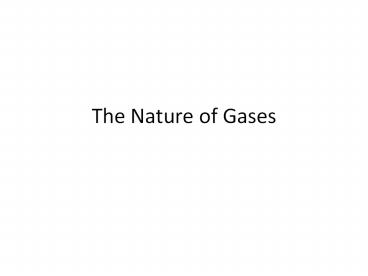The Nature of Gases - PowerPoint PPT Presentation
1 / 17
Title:
The Nature of Gases
Description:
The Nature of Gases Kinetic Theory and a Model for Gases The word kinetic refers to motion. The energy an object has because of its motion is called kinetic energy. – PowerPoint PPT presentation
Number of Views:92
Avg rating:3.0/5.0
Title: The Nature of Gases
1
The Nature of Gases
2
Kinetic Theory and a Model for Gases
- The word kinetic refers to motion.
- The energy an object has because of its motion is
called kinetic energy. - The kinetic theory states that the tiny particles
in all forms of matter are in constant motion.
3
Kinetic Theory and a Model for Gases
- A gas is composed of particles, usually molecules
or atoms. - They have insignificant volume and are relatively
far apart from one another.
4
Kinetic Theory and a Model for Gases
- The particles in a gas move rapidly in constant
random motion. They travel in straight paths and
move independently of each other. - As a result, gases fill their
- containers regardless of
- the shape and volume of
- the containers.
5
Kinetic Theory and a Model for Gases
- All collisions between gas molecules are
perfectly elastic. - During an elastic collision, kinetic energy is
transferred without loss from one particles to
another, and the total kinetic energy remains
constant.
6
Gas Pressure
- Gas pressure is defined as the force exerted by a
gas per unit surface area of an object. - Gas pressure is the result of simultaneous
collisions of billions of rapidly moving gas
particles with an object.
7
Gas Pressure
- If there are no gas particles present, there
cannot be collisions, and there is no pressure.
Such an empty space is called a vacuum.
8
Atmospheric Pressure
- Atmospheric pressure results from the collisions
of air molecules with objects. - Air exerts pressure on Earth because gravity
holds air molecules in Earths atmosphere. - Atmospheric pressure decreases as you climb a
montain because the density of the Earths
atmosphere decreases as elevation increases.
9
Atmospheric Pressure
10
Barometers
- Barometers are devices used to measure
atmospheric pressure. - This pressure is dependent on weather.
11
Pressure Units
- The SI unit of pressure is the pascal (Pa).
- Normal atmospheric pressure is about 100,000 Pa,
that is 100 kilopascals (kPa). - Two older unit of pressure are millimeters of
mercury (mmHg) and atmospheres (atm).
12
Pressure Units
- One standard atmosphere (atm) is the pressure
required to support 760 mm of mercury at 25 C. - 1 atm 760 mm Hg 101.3 kPa
13
Converting Units of Pressure
- A tire pressure gauge records a pressure of 450
kPa. What is this pressure measurement expressed
in atmospheres and millimeters of mercury?
14
Converting Units of Pressure
- 1. what pressure, in kilopascals and in
atmospheres, does a gas exert at 385 mm Hg? - 2. the pressure at the top of Mount Everest is
33.7 kPa. Is that pressure greater or less than
0.25 atm?
15
Kinetic Energy and Temperature
- As a substance is heated, its particles absorb
energy, some of which is stored within the
particles. - This stored energy, or potential energy, does not
raise the temperature of the substance. - The remaining absorbed energy speeds up the
particles (increases their kinetic energy), which
results in an increase in temperature.
16
Kinetic Energy and Temperature
- At any given temperature the particles of all
substances, regardless of physical state, have
the same average kinetic energy.
17
Kinetic Energy and Temperature
- Absolute zero (0K or -273.15C) is the temperature
at which the motion of particles stops (no KE). - The Kelvin temperature of a substance is directly
proportional to the average kinetic energy of the
particles of the substance.































